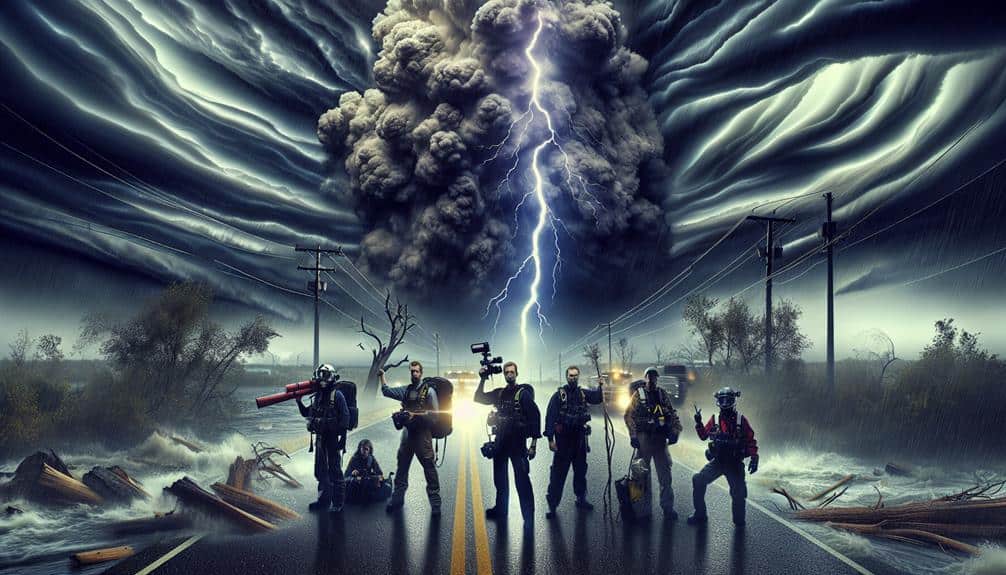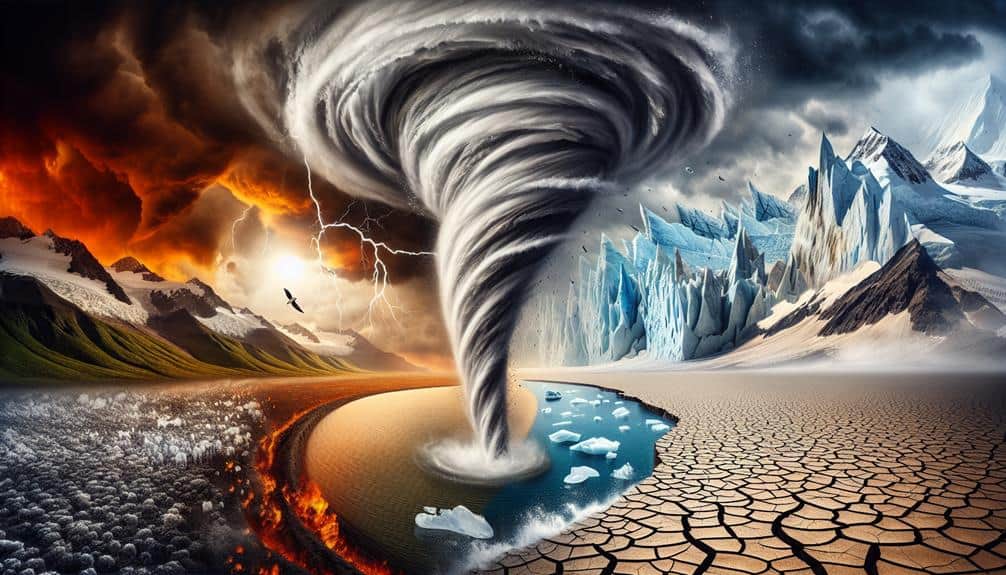We're witnessing storm patterns shift in a warming climate due to heightened atmospheric moisture and escalating sea surface temperatures. As the air warms up, it can retain more moisture, causing more vigorous and frequent storms. Increased ocean temperatures supply additional energy for storm formation, resulting in more powerful hurricanes, typhoons, and extreme weather occurrences. Furthermore, changes in wind directions and ocean currents play a role in unforeseeable weather variations. This increase in storm strength and frequency is closely connected to greenhouse gas emissions and escalating global temperatures. To comprehend the full scope of these impacts, we'll need to take into account the broader implications.
Key Points
- Rising global temperatures increase evaporation, leading to more moisture in the atmosphere, which fuels stronger and more frequent storms.
- Warmer ocean waters provide additional energy for storm systems, resulting in more intense and unpredictable weather patterns.
- Greenhouse gas emissions intensify storm patterns by raising atmospheric carbon dioxide levels, which correlate with more potent storms.
- Altered wind patterns and jet stream paths due to polar warming affect the direction and duration of storms.
Understanding Storm Dynamics
To fully grasp storm dynamics, we must analyze the interactions between atmospheric pressure, temperature variations, and moisture levels. These three elements are essential for storm formation. When warm, moist air rises, it creates an area of low pressure beneath it. Cooler air then rushes in to replace the rising warm air, leading to the development of storm systems.
By studying the specific atmospheric conditions that trigger these processes, we can better understand how storms form and behave. In the context of climate change, these dynamics are becoming increasingly vital. Rising global temperatures result in more evaporation, thereby increasing the moisture levels in the atmosphere. This, in turn, can intensify storm behavior, making storms more frequent and severe.
Data shows that the past few decades have seen an uptick in extreme weather events, correlating strongly with rising global temperatures. To navigate these changes, we must rely on precise, data-driven analysis of atmospheric conditions to predict storm formation accurately.
As we continue to study these phenomena, we gain the tools to mitigate risks and protect our communities. In an era where freedom to live safely is paramount, understanding storm dynamics is more essential than ever.
Greenhouse Gases and Storms
The intricate relationship between greenhouse gases and storm intensity becomes evident as we observe the escalation of extreme weather events correlated with increasing atmospheric carbon dioxide levels. As we continue to emit carbon into the atmosphere, these emissions trap heat, leading to a warmer climate. This warming has a direct impact on storm patterns, amplifying the frequency and severity of extreme weather.
Studies show that the rise in carbon emissions is linked to more potent storms. For instance, data from the National Oceanic and Atmospheric Administration (NOAA) indicate a marked increase in the intensity of hurricanes over the past few decades. This is partly due to the warmer air holding more moisture, which fuels stronger storms and leads to heavier rainfall.
Moreover, the Intergovernmental Panel on Climate Change (IPCC) reports that extreme weather events like cyclones and typhoons are becoming more frequent and devastating. The increasing concentration of greenhouse gases elevates the energy in the atmosphere, creating conditions conducive to more intense and destructive storm systems.
As we analyze these patterns, it's clear that reducing carbon emissions is essential in mitigating the adverse effects of extreme weather events. This connection underscores the importance of climate action for our collective freedom and safety.
Ocean Temperatures Rising
As ocean temperatures rise, we observe increased heat absorption, which directly impacts storm intensity.
This warming also alters ocean currents and circulation patterns, leading to more unpredictable weather systems.
Additionally, higher temperatures enhance evaporation rates, contributing to the formation of more powerful storms.
Increased Heat Absorption
Recent data indicates that ocean temperatures have been consistently rising, absorbing more heat than ever before. This increased heat absorption plays a pivotal role in altering heat distribution across the globe, which directly impacts storm behavior. Warmer ocean waters provide more energy for storm systems, often leading to more intense and frequent storms. As a result, we've observed notable changes in storm patterns, including shifts in their locations and intensities.
The climate impact of these rising ocean temperatures is multifaceted. For one, the additional heat in the ocean contributes to the evaporation rate, increasing the amount of moisture in the atmosphere. This moisture acts as fuel for storms, making them more powerful and widespread. Additionally, the altered heat distribution affects atmospheric pressure systems, further modifying storm behavior and leading to unpredictable weather patterns.
Altered Currents and Circulation
Rising ocean temperatures have noticeably altered global ocean currents and circulation patterns. We observe that warmer oceans disrupt the delicate balance of thermohaline circulation, which is essential for regulating climate.
Data from the National Oceanic and Atmospheric Administration (NOAA) shows significant shifts in the Gulf Stream, a key current that influences weather patterns along the eastern seaboard of the United States. When the ocean's thermal structure changes, it impacts the transport of heat and nutrients, leading to broader environmental consequences.
These altered ocean circulation patterns also affect atmospheric currents. Warmer sea surfaces increase the temperature gradient between the equator and the poles, modifying the jet stream's path. This shift in the jet stream can result in prolonged weather conditions, such as extended periods of drought or heavy rainfall.
According to recent studies, the Pacific Decadal Oscillation, a long-term ocean fluctuation, has been intensifying, further influencing atmospheric currents and storm trajectories.
We must recognize that these changes aren't isolated phenomena. The interconnectedness of our ocean and atmosphere means that even minor shifts can cascade into significant impacts on global weather patterns. Understanding these alterations is essential for predicting future storm behavior and preparing for their potential impacts.
Enhanced Evaporation Rates
Warmer ocean temperatures not only disrupt currents but also greatly enhance evaporation rates, contributing to more intense and frequent storms. As ocean temperatures rise, the rate of evaporation increases, leading to more moisture in the atmosphere. This additional moisture provides more fuel for storm systems, amplifying their severity and frequency. Understanding this evaporation impact is essential for recognizing the broader climate connection.
Here are the key points to bear in mind:
- Increased Moisture Content: Higher ocean temperatures increase the air's moisture-holding capacity, which can lead to heavier rainfall during storms.
- Energy Source for Storms: The excess moisture from enhanced evaporation serves as an energy source for storms, making them more powerful and potentially more destructive.
- Frequency of Extreme Weather Events: Data shows a correlation between rising sea surface temperatures and the frequency of extreme weather events like hurricanes and typhoons.
- Global Climate Patterns: Enhanced evaporation rates can alter global climate patterns, influencing weather systems far from the source of the initial evaporation.
Changes in Wind Patterns
In response to global temperature increases, wind patterns are exhibiting significant alterations, particularly in their intensity and direction. As temperatures rise, we observe changing patterns in wind direction, which can be attributed to shifts in atmospheric circulation. These shifts have a pivotal impact, influencing weather systems and storm formation across diverse regions.
We can measure how these changes in atmospheric circulation modify wind patterns by analyzing data from meteorological stations and satellite observations. For instance, the jet streams, which play an essential role in determining weather patterns, are now exhibiting increased waviness. This alteration in the jet streams can lead to prolonged weather events, such as extended periods of rain or drought, across various parts of the world.
Moreover, the polar regions are experiencing more pronounced warming, which affects the temperature gradient between the poles and the equator. This altered gradient disrupts established wind patterns, leading to more erratic and unpredictable weather.
Increased Storm Intensity

Recent data reveal a marked increase in storm intensity, as higher sea surface temperatures provide more energy for storm development. This correlation isn't just theoretical; it's supported by numerous studies and real-world observations. Let's explore the specifics.
We see that:
- Extreme Precipitation: Warmer air holds more moisture. As a result, storms now produce more rainfall, leading to increased flooding risks.
- Higher Wind Speeds: Enhanced thermal energy from warmer seas translates into stronger winds. This not only increases the physical damage but also amplifies the storm's overall power.
- Storm Surge: Rising sea levels and stronger winds contribute to more severe storm surges. Coastal areas face greater threats from these elevated water levels, exacerbating erosion and property damage.
- Frequency of Intense Storms: The number of Category 4 and 5 storms has risen. These storms aren't only more frequent but also more destructive, posing significant challenges for preparedness and recovery.
Regional Storm Variations
Understanding how warming affects storm intensity is important, but we must also consider how these changes manifest differently across various regions. Data indicates that storm impact varies significantly depending on geographic location.
For instance, regions like the Gulf Coast in the United States experience more frequent and intense hurricanes, while areas in the Midwest face increased occurrences of severe thunderstorms and tornadoes.
Our analysis shows that the varying storm impacts require tailored climate adaptation strategies. Coastal regions might focus on enhancing flood defenses and updating building codes to withstand stronger hurricanes, whereas inland areas could prioritize advanced warning systems and infrastructure improvements to mitigate tornado damage.
Additionally, changes in sea surface temperatures play a vital role in altering storm patterns. Warmer waters fuel more intense cyclones in tropical regions, while shifting jet streams can lead to unusual storm tracks in temperate zones.
Future Projections for Storms

As we project future storm patterns, we see evidence pointing to increasing storm intensity and shifting storm tracks.
Data indicates a higher frequency of extreme events, suggesting more severe impacts on affected regions.
We must analyze these trends to better understand their implications.
Increasing Storm Intensity
With rising global temperatures, we can expect an increase in the intensity of storms, supported by robust climate models and empirical data. This uptick in storm strength is characterized by both extreme rainfall and powerful winds, posing greater risks to our communities and infrastructure. Let's break down what the data tells us:
- Extreme Rainfall: Increased moisture in the atmosphere due to higher temperatures leads to heavier precipitation. Events of extreme rainfall are projected to become more frequent, exacerbating flooding risks.
- Powerful Winds: Warming oceans provide more energy for storm systems, resulting in more intense wind speeds. Such powerful winds can lead to extensive damage to buildings, power lines, and vegetation.
- Frequency of Severe Events: While the total number of storms mightn't notably increase, the proportion of high-intensity storms is expected to rise. This suggests a shift towards more frequent and severe weather events.
- Economic Impact: The monetary cost of storm damage is likely to spike as storms become more intense. This includes direct damage to property and infrastructure, as well as indirect costs like lost productivity and increased insurance premiums.
Our ability to adapt and mitigate these changes is essential for maintaining our quality of life and freedom.
Shifting Storm Tracks
Climate models indicate that storm tracks are shifting poleward, altering regional weather patterns and potentially increasing storm frequency in higher latitudes. This shift is linked to changes in the jet stream, the high-altitude winds that play a pivotal role in steering storms. As the climate warms, the jet stream's behavior becomes more erratic, which can disrupt traditional storm paths.
Recent data shows that the weakening of the polar vortex, a large area of low pressure and cold air surrounding the Earth's poles, is a significant factor. When the polar vortex weakens, it allows the jet stream to meander more than usual. This meandering can cause storms to deviate from their typical routes, leading to unprecedented weather patterns in regions that were previously unaffected.
Furthermore, the poleward shift of storm tracks means that areas closer to the poles are experiencing more frequent and intense storms. For instance, Northern Europe and parts of North America are seeing a rise in storm activity. This shift not only impacts weather patterns but also has profound implications for ecosystems, infrastructure, and human activities in these regions. Understanding these changes is essential for adapting to our evolving climate.
Frequency of Extreme Events
The poleward shift of storm tracks not only alters regional weather patterns but also leads to an increase in the frequency and intensity of extreme weather events. As we look into future projections for storms, several alarming trends emerge. The data indicates that with global warming, we're likely to experience more extreme precipitation events. This is because a warmer atmosphere holds more moisture, leading to heavier and more frequent rainfall.
Moreover, rising sea levels exacerbate the impact of coastal storms. Higher sea levels mean that storm surges will reach further inland, causing more severe flooding.
Here are four key projections that illustrate the changing frequency of extreme events:
- Increased Frequency of Heavy Rainfall: Models predict that extreme precipitation events could become 20-30% more frequent by the end of the century.
- Stronger Hurricanes: Warmer sea surface temperatures are likely to fuel more intense hurricanes, with higher wind speeds and more destructive potential.
- More Frequent Storm Surges: Rising sea levels could lead to a threefold increase in the frequency of storm surges.
- Extended Storm Seasons: The duration of storm seasons could lengthen, increasing the period during which we experience extreme weather events.
Frequently Asked Questions
How Do Changing Storm Patterns Impact Agricultural Productivity?
Changing storm patterns impact agricultural productivity by challenging crop resilience. We must improve weather forecasting to adapt. Accurate predictions help us mitigate damage, ensuring our crops withstand erratic weather, ultimately securing our agricultural freedom and productivity.
What Measures Can Individuals Take to Prepare for More Intense Storms?
Imagine a ship sailing through stormy seas: we need emergency kits as lifeboats and evacuation plans as our navigation charts. Data shows these preparations greatly increase our resilience and safety during more intense storms. Let's stay prepared.
Are There Any Economic Costs Associated With Changing Storm Patterns?
Yes, there are significant economic impacts from changing storm patterns. We must invest in infrastructure adaptation to mitigate costs related to property damage, business disruptions, and public safety concerns, ensuring economic resilience and individual freedoms.
How Do Changing Storm Patterns Affect Wildlife and Natural Habitats?
Changing storm patterns shake wildlife habitats to their core, reducing ecosystem resilience. We've seen species migration, altered food chains, and habitat loss. Data shows these changes disrupt the balance, challenging our efforts to maintain natural freedom.
What Role Do Urban Planning and Infrastructure Play in Mitigating Storm Damage?
We can mitigate storm damage through urban planning by implementing green infrastructure and promoting sustainable cities. Data shows that such measures reduce runoff, enhance resilience, and preserve our freedom to thrive amidst increasingly unpredictable weather patterns.


